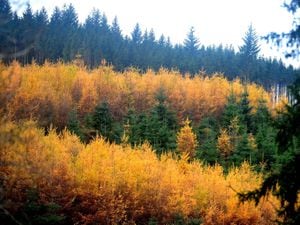Call to change UK’s forests to benefit climate, nature and people
A Soil Association report called for a move away from single-species plantations and clear felling to ‘regenerative forestry’.

Campaigners have urged a move from single-species tree plantations and clear felling forests to “regenerative forestry” to help nature, the climate and people.
A report by the Soil Association, which supports sustainable farming and land use, backs the planting of more diverse forests containing a mixture of species and putting more trees into farmland.
The charity highlights that 99% of plantation forests and 93% of native woodland are “not in good ecological condition”.
But more effective integration of farming and forestry, increasing the number of tree species in planting and protecting soils would maximise the benefits forests hold for storing carbon, providing habitats for wildlife and supporting livelihoods and people’s well-being, the Soil Association said.
New forests must be established with thought for their location and the different tree species they contain, and they need to link up with other habitats to help wildlife, the charity said.
Forests cover around 13% of the UK but the advisory Climate Change Committee has said that needs to rise to 19% by 2050 as part of efforts to tackle greenhouse gas emissions – and the Government has announced plans to significantly boost tree planting.
In 2019, the UK produced 11 million cubic metres of timber but four-fifths of the country’s consumption (81%) was met by imports, imposing a huge footprint on other countries, including those with poor environmental protections, the report said.
Regenerative forestry can increase the area of forest and woodland in the landscape, restore lost habitats and species and improve soil health at the same time as providing timber products, it argues.
The report calls for minimising the planting of single-species forest plantations and the practice of clear felling and restocking where large tracts of woods are grown and felled together leaving soil exposed.
Instead, there should be “continuous cover forestry” with a mixture of different conifers and broadleaved trees of different ages to maintain healthy conditions all the time.
Moves to less intensive systems and maintaining continuous cover, such as introducing broadleaved trees to conifer forests where they improve the forest litter and boost fungi that helps trees thrive and store more carbon, help nature and tackle climate change.
The report also calls for a farmer-led tree revolution with 5% of agricultural land under agroforestry by 2030 – integrating trees into farmland for crops and grazing animals, to provide shelter and shade for livestock, as well as new income streams, protect soils and reduce erosion and flooding.
By 2040, 10% of farmland should be under agroforestry, with half of all farms implementing it in some form. In addition the current one million hectares ( 2.5 million acres) of farm woodland should be doubled by 2050.
Soil Association senior forestry policy adviser Clive Thomas said: “We welcome the Government’s commitment to a large-scale programme of tree planting matched by widespread public support.”
But he said: “Government needs to move beyond the tree planting rhetoric to support a more integrated approach to land use in the UK.
“This means working with the forestry industry to create more productive and sustainable forests, putting farmers into the driving seat to achieve a UK tree revolution, planting a very significant number of additional trees on their land, and the widespread adoption of agroforestry – so creating tree abundant landscapes.”
He also said the UK’s forests – all areas with at least 20% tree cover – generally have low diversity of tree species, with nature continuing to decline in traditional woodlands, which needed to be reversed.
“It is critical to improve the health and diversity of our existing and future forests and woodland and their soils for them to achieve their full potential in tackling the combined climate, nature and health crises.”





